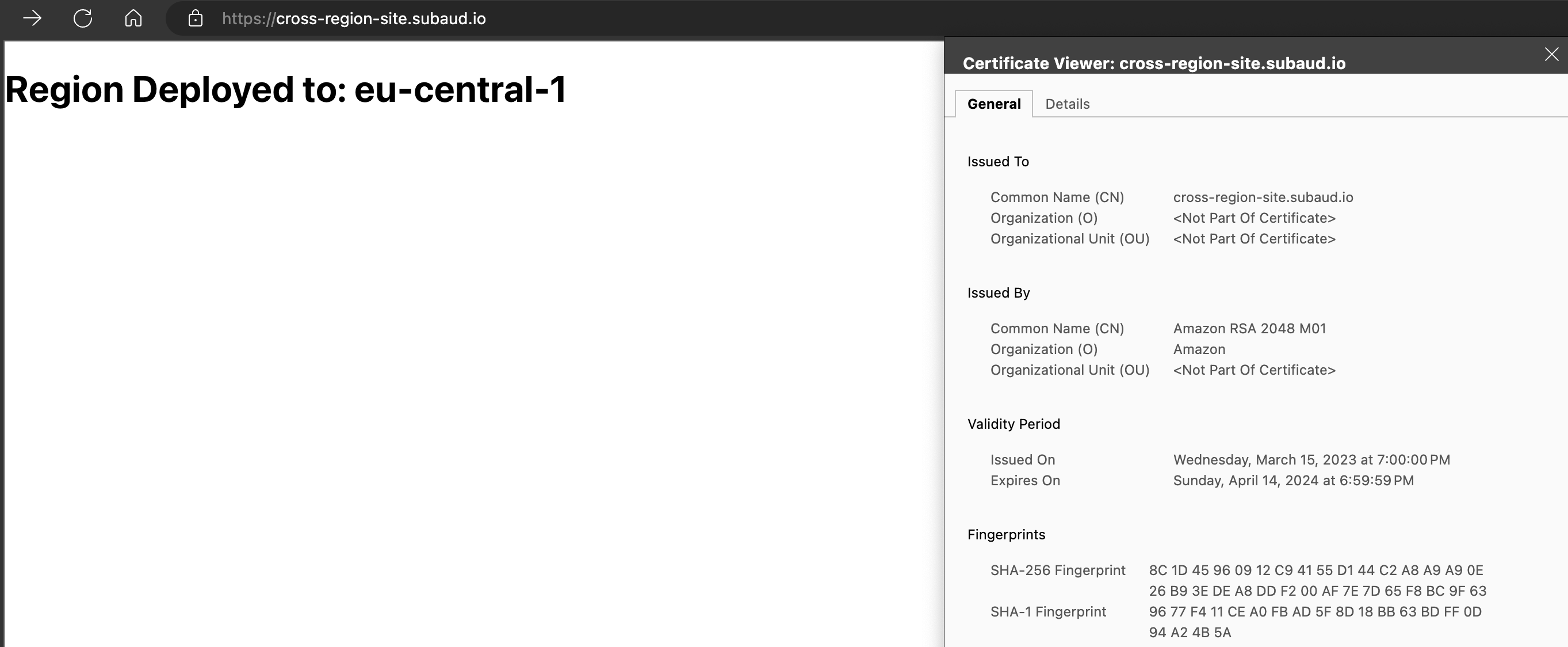AWS Certificate Manager (ACM) can be used to deploy TLS certificates for use with things like Amazon Cloudfront. However, ACM certificates must be deployed in us-east-1. In order to deploy an ACM certificate and associate with a resource outside of us-east-1, a multiple stack deployment must be used.
The first stack to be deployed will be the CertificateStack. This stack will create a Certificate in the us-east-1 region that can be used by a Cloudfront Distribution in another region.
interface CertificateStackProps extends StackProps {
siteSubdomain: string;
domain: string;
hostedZoneId: string;
}
export class CertificateStack extends Stack {
siteCertificate: Certificate;
constructor(scope: Construct, id: string, props: CertificateStackProps) {
super(scope, id, props);
const certificateResources = new CertificateResources(this, 'certificate', {
siteSubdomain: props.siteSubdomain,
domain: props.domain,
hostedZoneId: props.hostedZoneId,
});
this.siteCertificate = certificateResources.siteCertificate;
}
}
const app = new App();
const certEnv = {
account: process.env.CDK_DEFAULT_ACCOUNT,
region: 'us-east-1',
};
const certProps = {
siteSubdomain: process.env.SITE_SUBDOMAIN || '',
domain: process.env.DOMAIN || '',
hostedZoneId: process.env.HOSTED_ZONE_ID || '',
};
const certStack = new CertificateStack(app, 'CertificateStack', {
...certProps,
env: certEnv,
crossRegionReferences: true,
});
app.synth();Here we are explicitly declaring us-east-1 as the region to deploy this Stack to because ACM certificates used with CloudFront must use us-east-1. We are passing in to the Stack props from a .env file that will be used to create the Certificate. This Certificate will be used as input to the next Stack. Note that the Stack must take the input crossRegionReferences: true to let the next Stack use this Certificate.
interface SiteStackProps extends StackProps {
siteCertificate: Certificate;
siteSubdomain: string;
domain: string;
hostedZoneId: string;
}
export class SiteStack extends Stack {
constructor(scope: Construct, id: string, props: SiteStackProps) {
super(scope, id, props);
const site = new SiteResources(this, 'site', {
siteCertificate: props.siteCertificate,
siteSubdomain: props.siteSubdomain,
domain: props.domain,
hostedZoneId: props.hostedZoneId,
});
new CfnOutput(this, 'distributionURL', {
value: site.distribution.domainName,
});
new CfnOutput(this, 'siteUrl', {
value: `https://${props.siteSubdomain}.${props.domain}`,
});
}
}
const app = new App();
const siteEnv = {
account: process.env.CDK_DEFAULT_ACCOUNT,
region: 'eu-central-1',
};
const siteProps = {
siteCertificate: certStack.siteCertificate,
siteSubdomain: process.env.SITE_SUBDOMAIN || '',
domain: process.env.DOMAIN || '',
hostedZoneId: process.env.HOSTED_ZONE_ID || '',
};
new SiteStack(app, 'SiteStack', {
...siteProps,
env: siteEnv,
crossRegionReferences: true,
});
app.synth();Here we are creating a second Stack as part of this deployment. This Stack will deploy the actual website using the Certificate from the previous Stack. The props used for this Stack are the same as the previous Stack with the addition of the Certificate created in the first Stack. This Stack uses a typical Single-Page Application (SPA) deployment of S3 + CloudFront with a specific Certificate and ARecord assigned.
this.siteBucket = new Bucket(this, 'websiteBucket', {
publicReadAccess: false,
removalPolicy: RemovalPolicy.DESTROY,
autoDeleteObjects: true,
});
const hostedZone = HostedZone.fromHostedZoneAttributes(this, 'hostedZone', {
zoneName: props.domain,
hostedZoneId: props.hostedZoneId,
});
this.distribution = new Distribution(this, 'CloudfrontDistribution', {
enableLogging: true,
domainNames: [props.siteSubdomain + '.' + props.domain],
certificate: props.siteCertificate,
minimumProtocolVersion: SecurityPolicyProtocol.TLS_V1_2_2021,
defaultBehavior: {
origin: new S3Origin(this.siteBucket),
viewerProtocolPolicy: ViewerProtocolPolicy.REDIRECT_TO_HTTPS,
cachePolicy: CachePolicy.CACHING_DISABLED,
},
defaultRootObject: 'index.html',
});
new ARecord(this, 'clientSiteARecord', {
zone: hostedZone,
target: RecordTarget.fromAlias(new CloudFrontTarget(this.distribution)),
recordName: props.siteSubdomain + '.' + props.domain,
});The result will be an SPA deployed to S3 with a CloudFront Distribution that uses a specific URL from Route53 and a Certificate provided by ACM. This site can be deployed in any Region while the Certificate will be deployed in us-east-1 as required by CloudFront.
To deploy this demo, a .env file must be used. This .env file will contain the following:
SITE_SUBDOMAIN = 'cross-region-site'
DOMAIN = 'example.com'
HOSTED_ZONE_ID = 'Z00000000000000000000'The result is an SPA deployed to a non us-east-1 Region while still using an ACM Certificate used by CloudFront all deployed by CDK. Information on cross-region certificates is available on the AWS CDK Reference Documentation.

